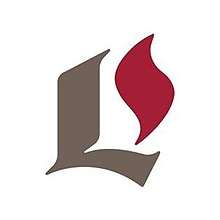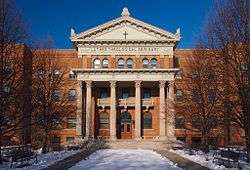Luther Seminary
 | |
| Type | Seminary |
|---|---|
| Established | 1869 |
| Affiliation | Evangelical Lutheran Church in America |
| Endowment | $90.3 million[1] |
| President | Robin Steinke |
Academic staff | 31[2] |
| Students | 526[2] |
| Location | St. Paul, Minnesota |
| Website |
www |
Luther Seminary is the largest seminary of the Evangelical Lutheran Church in America (ELCA). Located in the Saint Anthony Park neighborhood of St. Paul, Minnesota, its mission is to prepare students for service in rostered ministry and leadership positions within the ELCA and its ecumenical partners. Notably, it also accepts and educates students of 41 other denominations and traditions.[2] It is accredited by the Higher Learning Commission (formally known as the North Central Association of Colleges and Schools) and the Association of Theological Schools. It also has theological accreditation through the ELCA as well as the United Methodist Church.[3]
|
United Church Seminary | |
 | |
  | |
| Location |
2481 Como Avenue Saint Paul, Minnesota |
|---|---|
| Coordinates | 44°59′5″N 93°11′47″W / 44.98472°N 93.19639°WCoordinates: 44°59′5″N 93°11′47″W / 44.98472°N 93.19639°W |
| Built | 1900 |
| Architect | Didrik A. Omeyer; Martin P. Thori |
| NRHP reference # | 85003437[4] |
| Added to NRHP | October 31, 1985 |
History
Luther Seminary is the result of a series of mergers that consolidated what at one time were six separate institutions into one seminary.
Luther Theological Seminary
Luther Theological Seminary was initially formed through the merger of three institutions in 1917 in conjunction with the merger of three Norwegian Lutheran Churches to create the Norwegian Lutheran Church of America that same year of the 400th anniversary of the Protestant / Lutheran Reformation. As part of its Americanization process three decades later the NLCA changed its name to the Evangelical Lutheran Church (ELC) in 1946. The ELC became part of The American Lutheran Church (ALC) in 1960, the first inter-Lutheran consolidation to involve several different nationalities.
Each of the three churches in the NLCA / ELC operated a seminary: the Norwegian Synod operated Luther Seminary in Saint Paul, Minnesota founded in 1876; the Hauge Synod operated the Red Wing Seminary (1879) in Red Wing, Minnesota; and the United Norwegian Lutheran Church operated the United Church Seminary (1892) in Saint Paul. The merged seminaries occupied the site of the United Church Seminary which was the most developed and elaborate, and retained the name of the oldest of the three schools, namely, Luther Theological Seminary.
Presidents of Luther Theological Seminary
- Marcus Olaus Bøckmann 1892–1917 (United Church)
- Marcus Olaus Bøckmann 1917–1930
- T. F. Gullixson 1930–1954
- Alvin Rogness 1954–1974
- Lloyd Svendsbye 1974–1982
Augsburg Theological Seminary
Augsburg Theological Seminary, another constituent seminary later renamed Augsburg University, was founded in 1869 at Marshall, Wisconsin, later moved to Minneapolis, Minnesota, and ultimately was the seminary of the Lutheran Free Church of 1897. It remained a separate seminary until 1963 when the Lutheran Free Church merged with the American Lutheran Church three years after the second ALC's formation. At that time, Augsburg Seminary was united with Luther Theological Seminary. The merged institution took then Luther Theological Seminary name and the 1869 founding date of Augsburg Seminary.
Northwestern Lutheran Theological Seminary
Northwestern Lutheran Theological Seminary traces its origin to the Chicago Lutheran Divinity School, begun in Chicago, Illinois, in 1920 following action taken by the English Evangelical Lutheran Synod of the Northwest, a synod of the United Lutheran Church in America. In 1921, the seminary was moved to Fargo, North Dakota, and the following year to Minneapolis. From 1921 to 1982, its name was Northwestern Lutheran Theological Seminary. Located in north Minneapolis from 1922 to 1940 and in south Minneapolis from 1940 to 1967, it moved near the campus of Luther Theological Seminary in Saint Paul in 1967. At the time of the formation of the Lutheran Church in America (LCA) in 1962, Northwestern Lutheran Theological Seminary was placed under the jurisdiction of two supporting synods: the Minnesota Synod and the Red River Valley Synod.
Presidents of Northwestern Lutheran Theological Seminary
- Joseph Stump 1920–1935
- Paul Roth 1935–1950
- Jonas Dressler 1950–1957
- Clemens Zeidler 1957–1976
- Lloyd Svendsbye 1976–1982
Luther Northwestern Theological Seminary
Desiring to make witness to a shared mission in theological education, Luther and Northwestern Seminaries functionally unified in 1976, beginning with a single administration. After a period of six years, the two seminaries established a single seminary on July 1, 1982, known as Luther Northwestern Theological Seminary.
On January 1, 1988, Luther Northwestern Theological Seminary became affiliated with the Evangelical Lutheran Church in America (ELCA) formed by a merger of the LCA, the ALC, and the Association of Evangelical Lutheran Churches. The seminary's name was changed and simplified to Luther Seminary on July 1, 1994.
Academics
In the 2015–2016 academic year, Luther Seminary served 526 total students (45% male, 55% female), employing 31 faculty.[2] Luther offers a Master of Divinity degree (M.Div.) for students seeking ordination, as well as Master of Arts, Master of Theology, Doctor of Ministry (D.Min.), and Doctor of Philosophy degrees for other students. In the fall of 2013, Luther Seminary suspended new admissions to the Ph.D program for at least three years as part of budget cuts.[5] The seminary is planning to again offer the Ph.D program, with classing beginning in the Fall semester of 2018.[6]
As in most seminaries, M.Div. students complete three years of theological education, divided into a junior year (first), middler year (second) and senior year (final). A full year of internship, usually in a parish, is an integral part of pastoral training, and a degree requirement for ELCA M.Div. students. While individual situations may vary, internship typically begins after two-thirds of coursework has been completed. Thus, most students complete internship between their middler and senior year. The internship requirement is unique to the ELCA among the other mainline denominations in the U.S.
Frederick Buechner
Luther Seminary teaches works by the novelist Frederick Buechner. In 2014, Luther Seminary created the Lutheran Buechner Prize for Preaching.
Notable faculty
Notable alumni
Presidents of Luther Seminary
- Lloyd Svendsbye 1982–1987
- Gib Fjellman (interim) 1987
- David L. Tiede 1987–2005
- Richard Bliese 2005–2012
- Richard Foss (interim) 2012-2014
- Robin Steinke 2014-
See also
References
- ↑ As of June 30, 2015. "U.S. and Canadian Institutions Listed by Fiscal Year (FY) 2015 Endowment Market Value and Change in Endowment Market Value from FY 2014 to FY 2015" (PDF). National Association of College and University Business Officers and Commonfund Institute. 2016.
- 1 2 3 4 "Fast Facts". Luther Theological Seminary website. Retrieved 25 August 2017.
- ↑ "Accreditation". Luther Theological Seminary website. Luther theological Seminary. Retrieved 21 February 2016.
- ↑ National Park Service (2007-01-23). "National Register Information System". National Register of Historic Places. National Park Service.
- ↑ "Luther Seminary makes deep cuts to faculty and staff amid tough times for theological schools".
- ↑ "Ph.D Program". Luther Theological Seminary. Retrieved 21 February 2016.